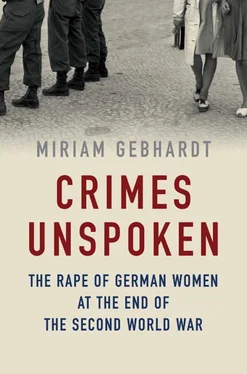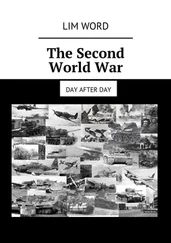According to eyewitness Cornelius Ryan, The Last Battle (London 1966).
The pregnancy rate following rape is currently 5 per cent in the USA and approx. 15 per cent in Mexico, see Susanne Heynen, ‘Erzwungene Schwangerschaft und Mutterschaft durch eine Vergewaltigung’, in: Kindesmisshandlung und -vernachlässigung (DGgKV) 6, no. 1/2 (2003), pp. 98–125. Barbara Johr assumes a 20 per cent rate for pregnancies following rape. In my opinion, she arrives at this high figure from hospital records. It is not clear, however, which women attended clinics at the time after being raped. I believe it was, above all, women who feared that they must be pregnant. Helke Sander and Barbara Johr also assume an abortion rate of 90 per cent, see Barbar Johr, ‘Die Ereignisse in Zahlen’, in: Helke Sander and Barbara Johr (eds.), BeFreier und Befreite: Krieg, Vergewaltigungen, Kinder (Munich 1992), pp. 46–73.
Bayerisches Hauptstaatsarchiv (BayHStA) MInn 80207 betreff Besatzungsmacht, Ereignisse und Sicherheitsstörungen, Bericht des Landeserkennungsamt Bayern of 28 June 1946.
Bundesarchiv (BA) Koblenz B/126/28038.
Ibid., B 153/342.
National Archives, Headquarters XX Corps Office of the Provost Marshal, Reply to questions on rape, file no. 70, 5 June 1945: Rape of German women by American soldiers (National Archives ID 6081861).
Ulrich Herbert, Geschichte Deutschlands im 20. Jahrhundert (Munich 2014), p. 534, with reference to Regina Mühlhäuser, ‘Vergewaltigungen in Deutschland: Nationaler Opferdiskurs und individuelles Erinnern betroffener Frauen’, in: Naumann, Nachkrieg in Deutschland , pp. 384–408, which in turn is based on figures by Helke Sander and Ingrid Schmidt-Harzbach. The high figure for Austria is based on an obscure formula attributing an average of two rapes for every occupying soldier. Barbara Stelzl-Marx mentions this rule of thumb without stating whether it applies to all occupying armies or just the Soviets; see Stelzl-Marx, Stalins Soldaten in Österreich , p. 411.
Norman M. Naimark, Die Russen in Deutschland: Die sowjetische Besatzungszone 1945 bis 1949 (Berlin 1997), p. 170.
J. Robert Lilly, Taken by Force: Rape and American GIs in Europe during World War II (Chippenham 2007, first published in French in 2003).
Johr, ‘Die Ereignisse in Zahlen’, p. 72, fn. 2.
See Norman M. Naimark, ‘The Russians and Germans: Rape during the War and Post-Soviet Memories’, in: Raphaëlle Branche and Fabrice Virgili (eds.), Rape in Wartime: A History to Be Written (= Genders and Sexualities in History) (Basingstoke 2012), pp. 201–19.
It is possible that the entire female population was erroneously used as a basis.
Johr, ‘Die Ereignisse in Zahlen’, pp. 58–65.
Branche and Virgile (eds.), Rape in Wartime.
Werner Sudendorf, Verführung und Rebell: Horst Buchholz, Die Biografie (Berlin 2013), p. 23.
Landeserkennungsamt Bayern, 19 June 1946, BayHStA MInn 80207, Bd. 1 betreff Besatzungsmacht, Ereignisse und Sicherheitsstörungen.
Stadtpolizei Bad Kissingen on 7 December 1951 to Regierung von Unterfranken, BayHStA MInn 80208.
Staatsarchiv Freiburg Einzelfälle D 5/1 11.6.30/5537.
The Deutscher Tagebucharchiv in Emmendingen has several dozen sources that await analysis.
Sammlung Sterz, Feldpostbriefe, Bibliothek für Zeitgeschichte, Stuttgart, quoted in Ian Kershaw, The End: Hitler’s Germany, 1944–45 (London 2011), p. 312.
Hildebrandt and Kuballa, Mein Kriegsende , p. 221.
Wladimir Gelfand, Deutschland-Tagebuch 1945–1946: Aufzeichnungen eines Rotarmisten (Berlin 2008), p. 112.
Christian Goeschel, Selbstmord im Dritten Reich (Berlin 2011), p. 242; more generally, Kershaw, The End , pp. 112–15, 188.
Max Domarus (ed.), Hitler: Reden und Proklamationen, kommentiert von einem deutschen Zeitgenossen , vol. II/2 (Leonberg 1988), pp. 2204–5.
Elke Fröhlich (ed.), Die Tagebücher von Joseph Goebbels, Teil I, Aufzeichnungen , vol. 4 (Munich 1987), p. 696.
Christel Panzig and Klaus-Alexander Panzig, ‘“Die Russen kommen!” Deutsche Erinnerungen an Begegnungen mit “Russen” bei Kriegsende 1945 in Dörfern und Kleinstädten Mitteldeutschlands und Mecklenburg-Vorpommerns’, in: Elke Scherstjanoi (ed.), Rotarmisten schreiben aus Deutschland: Briefe von der Front (1945) und historische Analysen ( = Texte und Materialien zur Zeitgeschichte 14, published by the Institut für Zeitgeschichte) (Munich 2004), pp. 340–68.
Kriegsende und Neubeginn in Landkreis Eichsfeld 1945/1946 (Heiligenstadt 2003), p. 267.
The rumours at the time went in both directions. The colonial soldiers were said to lust violently after German women, and German women to fraternize immorally with the enemy; see Christian Koller, ‘Feind – Bilder: Rassen und Geschlechterstereotype in der Kolonialtruppendiskussion Deutschlands und Frankreichs, 1914–1923’, in: Karen Hagemann, Ralf Pröve and Stefanie Schüler-Springorum (eds.), Heimat-Front: Militär und Geschlechterverhältnisse im Zeitalter der Weltkriege (Frankfurt 2002), pp. 150–67.
Kurt Redmer, Die letzten und die ersten Tage: Dokumentation über Geschehnisse in Mecklenburg im 2. Weltkrieg und danach (Schwerin 2007), pp. 121–8.
Goeschel, Selbstmord im Dritten Reich , p. 241.
Ibid.
Albin Segmüller, Über reactive Selbstmorde und Selbstmordversuche in der Nachkriegszeit (Nuremberg 1949).
Bundesministerium für Vertriebene (ed.), Dokumentation der Vertreibung der Deutschen aus Ost-Mitteleuropa , vol. I/1 (Bonn 1954–6), p. 226.
Goeschel, Selbstmord im Dritten Reich.
See Kershaw, The End , pp. 114–17, 120, 122.
Margret Boveri, Tage des Überlebens: Berlin 1945 (Munich 1985), p. 43.
See Heinrich Schwendemann, ‘Das Kriegsende im Ostpreussen und in Südbaden in Vergleich’, in: Bernd Martin (ed.), Der Zweite Weltkrieg und seine Folgen, Ereignisse, Auswirkungen, Reflexionen (Berlin 2006), pp. 91–112.
Bundesministerium für Vertriebene (ed.), Dokumentation der Vertreibung der Deutschen , vol. I/1, pp. 28–31, 106.
Bärbel Gafert, ‘Kinder der Flucht – Kinder der Vertreibung 1945–1948’, in: Deutschland-Archiv 40, 4/6 (2007), pp. 833–5.
Leonie Biallas, Komm, Frau, raboti: Ich war Kriegsbeute (Leverkusen 2010), pp. 17–18.
Читать дальше











